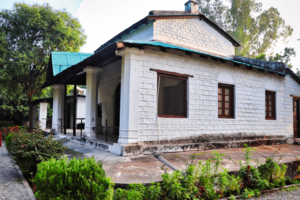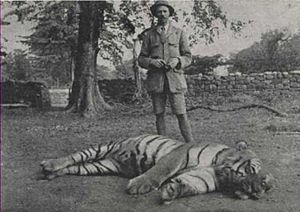Jim Corbett facts for kids
Quick facts for kids
Jim Corbett
CIE VD
|
|
|---|---|
| Born |
Edward James Corbett
25 July 1875 Nainital, North-Western Provinces, British India
|
| Died | 19 April 1955 (aged 79) Nyeri, Colony of Kenya
|
| Resting place | Saint Peter's Cemetery Nyeri, Nyeri, Kenya |
| Nationality | British |
| Occupation |
|
Edward James Corbett (born July 25, 1875 – died April 19, 1955) was a famous British hunter, tracker, naturalist, and author. He is best known for hunting man-eating tigers and leopards in India. He was also a colonel in the British Indian Army. The government often asked him for help to stop dangerous big cats that were attacking people in villages.
Corbett wrote several popular books about his adventures, including Man-Eaters of Kumaon and Jungle Lore. He also became a keen photographer and worked hard to protect India's wildlife.
Contents
Early Life and Adventures
Jim Corbett was born on July 25, 1875, in Nainital, India. He was one of sixteen children in his family. His father was the postmaster of Nainital. In winter, his family would move to a cottage in a village now called Kaladhungi.
From a young age, Jim loved the forests and animals around his home. He spent a lot of time exploring and learned to identify many animals and birds just by their sounds. This helped him become a very skilled tracker and hunter. He went to school in Nainital, but he left before he was nineteen.
He then started working for the Indian Railways. He worked as a fuel inspector and later helped move goods across the Ganga River. Jim Corbett even started a school for railway workers.
Hunting Dangerous Man-Eaters
During his life, Jim Corbett tracked and hunted many leopards and tigers. About a dozen of these were known man-eaters, meaning they had attacked and killed people. In his books, Corbett estimated that these big cats had killed over 1,200 people.
One of the most famous man-eaters he killed was the Champawat Tiger. This tiger was responsible for an estimated 436 deaths. Jim Corbett also successfully hunted two man-eating leopards. The Panar Leopard was said to have killed 400 people. The Leopard of Rudraprayag terrorized people traveling to holy shrines for over eight years, causing more than 126 deaths.
Corbett found that most of the man-eating animals were sick or injured. For example, some had porcupine quills stuck deep in their skin or old gunshot wounds that hadn't healed. These injuries likely made it hard for them to hunt their usual prey, so they started attacking humans.
Corbett usually hunted alone and on foot, even when chasing very dangerous animals. He sometimes hunted with his small dog, Robin, who he wrote about in his books.
From Hunter to Naturalist
In the late 1920s, Jim Corbett bought his first camera. Inspired by his friend Frederick Walter Champion, he began to film tigers. Even with his deep knowledge of the jungle, it was very difficult to get good pictures because the animals were extremely shy.
Corbett didn't only hunt man-eaters. For example, he killed the very large Bachelor of Powalgarh tiger, even though it had never harmed a human.
Jim Corbett and Frederick Champion played a big part in creating India's first national park in the Kumaon Hills. It was first named Hailey National Park, but in 1957, it was renamed the Jim Corbett National Park in his honor.
Corbett cared deeply about the poor people of India. He dedicated his book My India to them. The money earned from his book Man-Eaters of Kumaon was given to a school for blind war veterans.
Jim Corbett lived in Gurney House in Nainital with his sister. They sold the house before moving to Kenya in 1947. Today, Gurney House is a private home that has been turned into a museum about Jim Corbett.
He also spent time in Chotti Haldwani, a village he cared for. In 1925, Corbett and the villagers built a wall around the village to keep wild animals out. This wall still stands today and has protected the villagers from animal attacks.
Later Life in Kenya
After 1947, Jim Corbett and his sister Maggie moved to Nyeri, Kenya. He continued to write and warn people about the decreasing numbers of wild cats and other animals.
In 1952, Corbett was at the Treetops Hotel, a hut built in a giant ficus tree. He was there as a bodyguard for Princess Elizabeth. While she was staying there, her father, King George VI, died, and Elizabeth became Queen.
Jim Corbett died of a heart attack in 1955, shortly after finishing his last book, Tree Tops. He was buried at St. Peter's Anglican Church in Nyeri.
His book Man-eaters of Kumaon was very successful around the world and was translated into 27 languages. His fourth book, Jungle Lore, is considered his autobiography.
In 1968, one of the five remaining types of tigers was named after him: Panthera tigris corbetti, also known as the Indochinese tiger or Corbett's tiger.
Personal Life
Jim Corbett never married.
Movies and TV Shows
In 1948, a Hollywood movie called Man-Eater of Kumaon was made. It was based on the success of Corbett's book, but the story was completely new. Jim Corbett himself said that "the best actor was the tiger!"
Later, in 1986, the BBC made a TV show called Man-Eaters of India. An IMAX movie, India: Kingdom of the Tiger, was made in 2002, based on Corbett's books. There was also a TV movie in 2005 based on The Man-Eating Leopard of Rudraprayag.
Honors and Legacy
Jim Corbett received several awards for his work, including the Kaisar-i-Hind Medal and being made a Companion of the Order of the Indian Empire.
Many things have been named in his honor:
- The Jim Corbett National Park in India was renamed after him in 1955–56. He had helped create this protected area in the 1930s.
- The Indochinese tiger was named Panthera tigris corbetti in 1968.
- A fictional book about his life, In the Jungles of the Night: A Novel about Jim Corbett, was written in 2016.
Books by Jim Corbett
- Jungle Stories (1935)
- Man-Eaters of Kumaon (1944)
- The Man-eating Leopard of Rudraprayag (1947)
- My India (1952)
- Jungle Lore (1953)
- The Temple Tiger and More Man-eaters of Kumaon (1954)
- Tree Tops (1955)
- Jim Corbett's India – Selections by R. E. Hawkins (1978)
- My Kumaon: Uncollected Writings (2012)
See also
 In Spanish: Jim Corbett para niños
In Spanish: Jim Corbett para niños
- Literary references to Nainital
- Kenneth Anderson, another writer about hunting in South India
- Hunter-naturalists of India
- List of famous big game hunters
- Project Tiger





